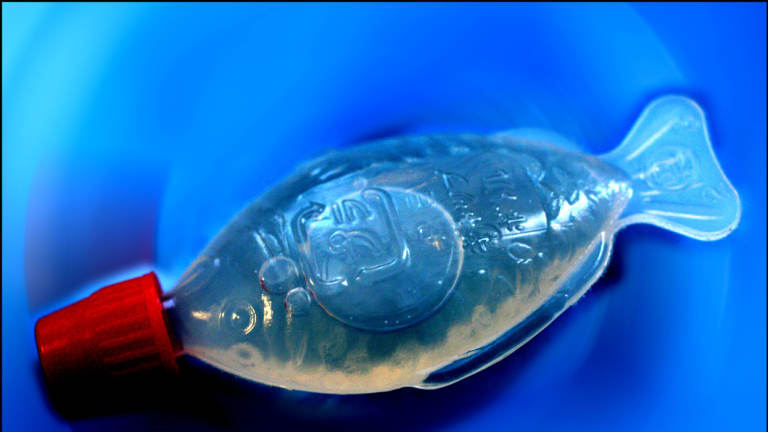Home » Health News »
Beware the heart-health dangers of very salty Asian sauces
Talking points
- One tablespoon of fish sauce has about 96 per cent of our daily salt limit.
- One tablespoon of soy sauce has about 61 per cent of our daily salt limit.
- One tablespoon of oyster sauce has about 36 per cent of our daily salt limit.
We know that there are about 10 teaspoons of sugar in a can of Coke, but do you know how many teaspoons of salt are in the soy sauce you season your vegetables or sushi rolls with?
Much more than you might think.
Soy sauce: a salty problemCredit:Cathryn Tremain
We tend to think of Asian sauces as healthier options, which has led to an increase in their popularity.
But, a new report by The George Institute for Global Health, VicHealth and the Heart Foundation analysing the salt content of 150 Asian style sauces on Australian supermarket shelves shows this is not always the case.
Changs Light Soy sauce was the saltiest soy on our shelves; a 500 ml bottle contained the equivalent of about 23 teaspoons of salt and about 4.4 grams of salt per serve.
“It’s almost a total day’s worth – 5 grams or a flat, level teaspoon of salt – in a single serving, which is huge,” said The George Institute’s Public Health Nutritionist and the report’s lead author Clare Farrand.
“A serving size is about 20 ml but we tend to douse it on our food so we might even be eating more than that.”
The World Health Organisation (WHO) recommends a limit of 5 grams of salt per day, but Farrand explains we can do with less.
“We only need about one gram of salt for normal physiological function,” she said.
Too much salt raises our blood pressure, increasing our risk of heart attack, heart disease and stroke. A 2014 Harvard paper linked excess salt consumption with 1.65 million cardiovascular-related deaths globally each year.
“There are no symptoms for raised blood pressure,” Farrand said. “So you’re putting yourself at risk of cardiovascular disease and you really don’t even know anything about it.”
If we ate a diet of fresh fruits, vegetables and whole-grains, adding a little salt (or soy) would be fine.
“But the reality is that’s not the case,” Farrand pointed out.
Only one in 10 Australians manage the recommended daily intake of fresh fruits and vegetables, while most Australian adults eat about 9 grams of salt a day – almost double the WHO recommendation.
Currently, about 80 per cent of our salt intake comes from pre-prepared foods.
The problem with sauce is insidious because as condiments to our foods they are easy to overlook as the sources of our salt intake, even when we are attempting to be healthier.
“A single serving of the highest salt soy sauce to your vegetable stir fry, you would be hitting your entire day’s worth of salt in just that," Farrand said.
As for countries like Japan, where high life expectancy rates are attributed to diet, Farrand points out they have introduced initiatives to reduce the salt in soy because hypertension and cardiovascular disease are becoming increasing problems.
Reduced salt products are available in Australia too.
The George Institute report found Kikkoman Naturally Brewed Less Salt Soy Sauce had the equivalent of about 11 teaspoons in a 600ml bottle; about three times less than the saltiest soy.
“There are some better versions on the market; there are some sauces that contain huge reductions in the amount of salt in their product,” said Farrand, who adds that they are working with the government to try and create salt, fat and sugar reduction “targets” for the food industry to work towards.
“It can be done by the food industry because some are already doing it and that is really the only way we can reduce population-level salt intake… because we recognise that these are the types of foods people are eating," she explained.
In the meantime, it’s up to us to choose our products carefully.
“In this instance, its reading the label and trying to choose the lower salt option, being aware of how much soy sauce you’re using,” she advised.
“You might be mindlessly dousing it over everything, but if you know this is going to add so much salt to your diet, you might try to add a bit more carefully.”
Tips for consumers:
- Be aware of portion size and try to use salty sauces sparingly
- Use natural, no-salt flavourings such as lemon, herbs and spices, including fresh garlic, chilli, ginger and vinegar when preparing Asian style meals
- The best way to reduce salt is to eat more fresh foods and reduce your reliance on processed and packaged foods including pre-made sauces
- Sodium is one component of salt – it is the sodium that is labelled on nutrition information panels on packaged foods
- Choose ‘reduced salt’ products and check the label to choose the lower sodium option
- Download the FoodSwitch app to scan product barcodes to find an alternative product with a lower sodium content. Available to download from www.foodswitch.com.au
- Use the Australian Guide to Healthy Eating as a guide to make healthier choices
- Visit www.unpackthesalt.com.au to sign up to the 10 day Salt Challenge and for tips and resources on how to identify salt in packaged foods and reduce your salt intake.
Source: Read Full Article


